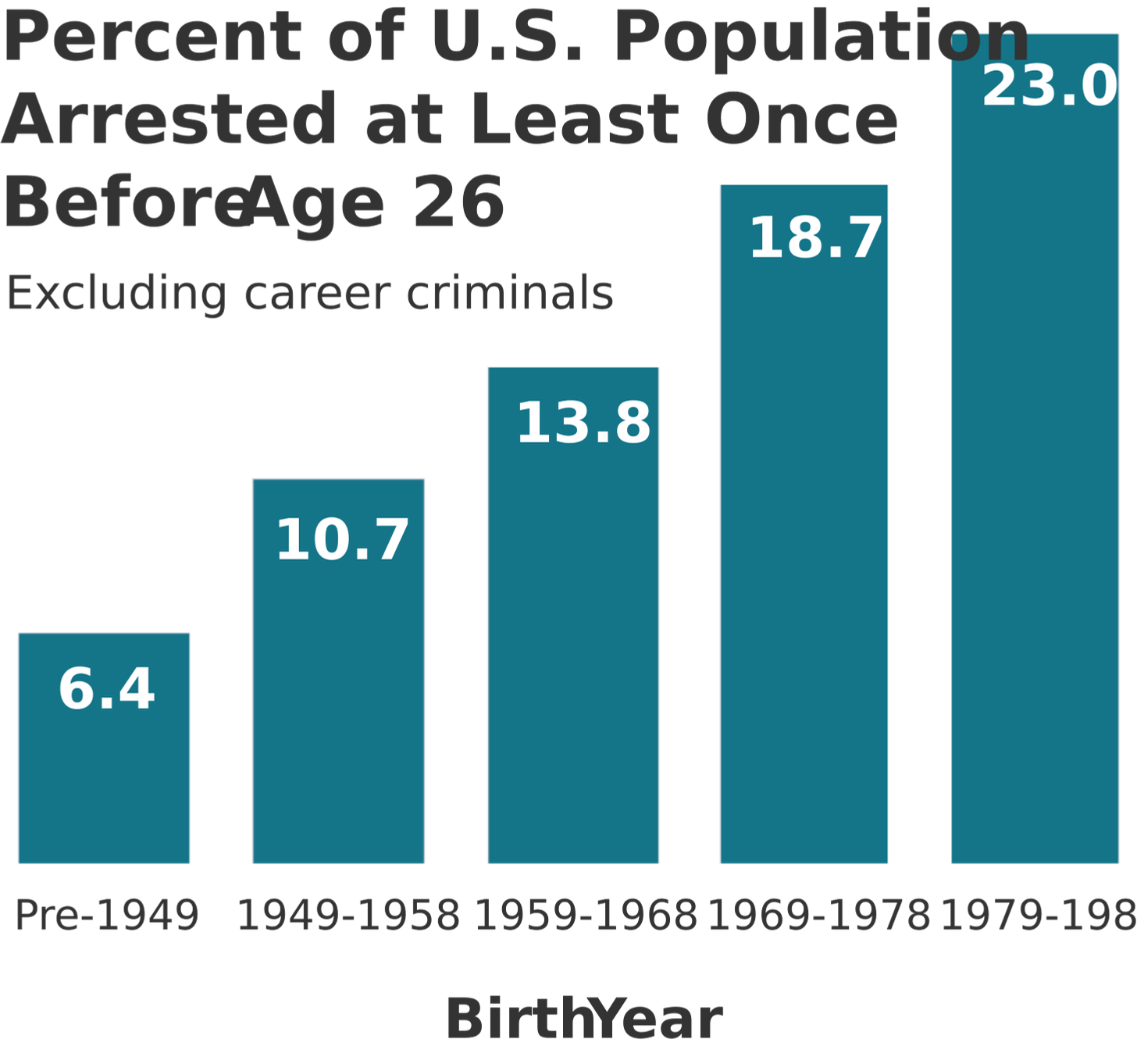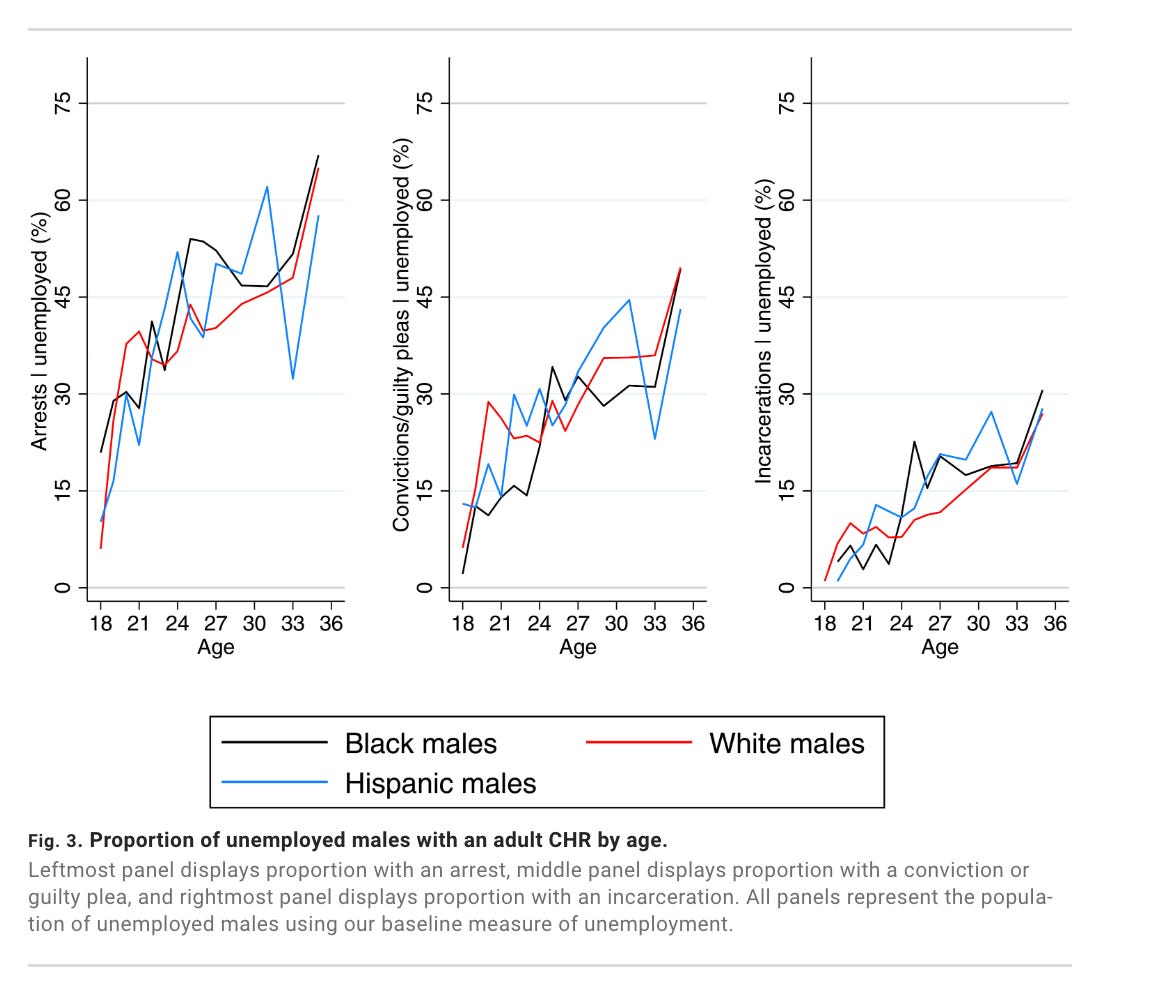Occasionally a number you come across just stops you in your tracks. This one did last week.
A RAND study dated to 2018/9 found that
Among (American) men aged 26 to 35 with less than a high school education, 60 percent of the men reported having been arrested by age 26. That compares with about 23 percent of male college graduates in the same age group, with little difference between racial groups.
Let that sink in for a moment.
60 percent of young men in America, who at a first approximation might be described as working-class – having less than high-school education – have been arrested at least once by the age of 26.
Strikingly, the reports author James P. Smith found that the rate of arrest has gone up dramatically over time.

Percentage of U.S. population arrested at least once by age 26 cohorts, different cohorts.
Source: RAND
Americans aged 26–35 in the 2010s were 3.6 times more likely to have been arrested by 26 when compared with those who were age 66 and older. Across all educational classes and racial categories, roughly a third of men in America aged 26–35 in the 2010s had been arrested by 26, 2.6 times the rate of those 66 and older.
Rising arrest rates have gone hand in hand with higher rates of conviction.
The unconditional conviction rate among the young Americans examined has risen dramatically over time, especially for women. Across all groups, Americans ages 26–35 were 6.5 times more likely to have been convicted of a crime by 26 when compared with the oldest age group in the study.
Black men were significantly more likely to have been arrested. Of black men aged 26-35 in the study, 33 percent for black men had been arrested by the age of 26 versus 23 percent for white men. But the upward trend for white men was muchmore dramatic. For white men the arrest rate has surged by a factor of three in recent decades.
Furthermore, racial differences and educational hierarchies are tightly linked.
Education, the study data show, plays an outsized role in explaining racial arrest differences, especially for men in the 26–35 age group. … The overall higher rate of arrests by 26 among black adults in the 26–35 age group correlates with lower education levels. The study also found that having a more educated father was associated with lower rates of arrests and convictions by 26 and that being arrested by that age was associated with a reduction in schooling of almost half a year on average, with this effect almost doubled to a reduction of a year of schooling if there were multiple arrests by 26.
Where racial differences are most pronounced are in the incidence of repeated arrest.
Multiple arrests are becoming far more common over time, with 11 percent of those ages 26–35 experiencing more than one arrest by 26. This is a common occurrence for the black men studied in the 26–35 age group, with more than a quarter of them arrested more than once by 26.
Whereas it once was very rare for women to be arrested – about one in 100 for women over 66 – now one out of seven women 26–35 years old had been arrested at least once by 26.
Being arrested when young, even once, whether or not it leads to a conviction, is associated with a lot of other very bad outcomes. The reports author James P. Smith found that
being arrested for a crime was associated with a 3.5 percentage point drop in the likelihood of being married, with multiple arrests further lowering the likelihood of marriage. People arrested only once during childhood had about $6,000 less in annual earning as adults, with the earnings even lower (about $13,000 less) if someone had multiple arrests during childhood. People with violence or drug arrests averaged about $11,000 less in annual earnings. … The average lifetime penalty for being arrested by age 26 would be $180,000, with an additional lifetime penalty of about $275,000 for multiple arrests by age 26.
The causes of arrest varied greatly.
“other misdemeanors” representing 31 percent of arrests for women and 28 percent for men. Underage drinking accounted for 11–16 percent of all arrests. … Assaults, robberies, and thefts combined accounted for 19 percent of all arrests for men and 28 percent for women in the study. Similarly, drugs were the reason for arrests in 9 percent of the cases for men and about 8 percent for women.
But it is implausible to suggest that such a huge surge in criminalization can have been entirely to do with a greater amount of criminal behavior. And if it were it would beg the question of what was defined as criminal. A substantial surge in enforcement is clearly a contributing factor.
Mass incarceration is the most dramatic and most spectacularly damaging aspect of the criminalization of American society, but the damage done is far more all-pervasive than even the extraordinary figures for the American prison population would suggest.
According to the FBI, somewhere in excess of 77 million Americans have what the FBI deems to be a “criminal record”, approximately a quarter of the total population. More Americans are recorded in the FBI’s criminal database than have College degrees.
America’s policing and criminal justice systems are a gigantic apparatus for the destruction of human capital and life chances that damages above all minorities and America’s working-class.
As the NCSL records:
Individuals with criminal records face many barriers to licensure including both those codified in federal and state law as well as implicit biases. The National Inventory of Collateral Consequences of Conviction (the NICCC), catalogs over 15,000 provisions of law in both statute and regulatory codes that limit occupational licensing opportunities for individuals with criminal records. … A report by the U.S. Bureau of Justice Statistics showed that of the 25.9 million fingerprint records processed by states and territories in 2016, 44 percent were used for criminal justice purposes and 14,623,300 were used and submitted for licensing, employment and regulatory purposes.” These fingerprint records may include juvenile records, which may be confidential, “arrests without disposition” (with no charges or charges with no conviction), expunged or sealed records, or information that a person acquired due to misidentification or identity theft.
A criminal record substantially prejudices peoples chances in the labour market. And this shows up in the pool of those who remain unemployed even when the labour market is hot. As a recent RAND study found.
men between the ages of 30 and 38 who were unemployed in 2017 had substantial levels of involvement with the criminal justice system, with the majority having been arrested at least once. Almost 40 percent had been convicted of a crime at least once and more than 20 percent had been incarcerated at least once.

Source: Bushway et al 2022
Any discussion of the lagging labour market participation of both American men and women and America’s inequality, must taken into account the extraordinary impact of its overgrown criminal justice system.
***
Thank you for reading Chartbook Newsletter. I love sending out the newsletter for free to readers around the world. I’m glad you follow it. It is rewarding to write, but it takes a lot of work. What sustains the effort are voluntary subscriptions from paying supporters.
Several times per week, paying subscribers to the Newsletter receive the full Top Links email with great links, reading and images.
If you would like to join the group of supporters there are three subscription models:
- The annual subscription: $50 annually
- The standard monthly subscription: $5 monthly – which gives you a bit more flexibility.
- Founders club:$ 120 annually, or another amount at your discretion – for those who really love Chartbook Newsletter, or read it in a professional setting in which you regularly pay for subscriptions, please consider signing up for the Founders Club.
